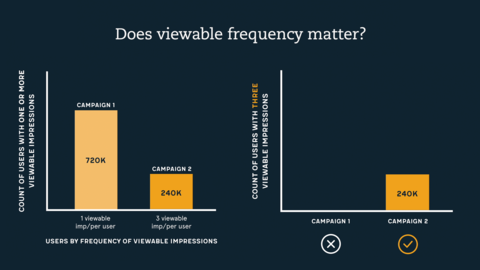December 7, 2018
Say you’re a media planner who just wrapped a digital campaign, and that the overall viewability rate for the campaign was 72%.
High fives all around, right?
Not necessarily. A simple viewability rate (viewable impressions over served impressions) doesn’t tell you anything about frequency management.
Here are some questions you should ask yourself to put your viewability rate into the proper context:
Who did I reach, and how?
Amazingly, frequency management in 2018 is still being thought of merely in terms of served impressions. But a served impression is not necessarily a viewable one. You can’t say you’ve truly reached someone with a below-the-fold ad.
Put another way: why are we insisting on measuring viewability at all, if we don’t apply it to our frequency management?
Say our client’s desired frequency is three impressions. If campaign 1 and campaign 2 both delivered 1M impressions with a viewability rate of 72%, but those 720K viewable impressions were distributed among 720K users for campaign 1, and among 240K users for campaign 2, it should be obvious that campaign 1 failed while campaign 2 succeeded.
All of this points to the need for marketers and agencies to look at viewability on the user level, rather than on the level of the campaign or placement.

Which domains helped me reach those users?
Marketers and publishers alike are used to looking at viewability rates aggregated to the level of the domain. But here again, these rates can be misleading.
Imagine you’re a publisher, and your client has told you that their desired frequency per user is 3 impressions. As part of fulfilling their I/O, you’ve managed to serve them 900 impressions on each of two domains, with domain 1 having a viewability rate of 83% (750 viewable impressions out of 900 served), and domain 2 having a viewability rate of 33% (300 viewable impressions out of 900 served).
Domain 1 is the better domain, right?
Again, not necessarily. It all depends on how many users were reached with those viewable impressions. If domain 2’s 300 viewable impressions went to 100 users, each with a frequency of 3, then domain 2 achieved the advertiser’s objective; while if domain 1’s 750 viewable impressions were scattered among as many users, then it failed to achieve that objective.

Unless a user-level analysis of viewability is performed, advertisers and publishers alike may undervalue some domains and overvalue others because of an aggregate viewability rate.
How will I find those users again?
Say your campaign is hitting its goal of serving 3 viewable impressions per user. The users you found are obviously valuable. But will you ever be able to find them again? Even if they move to different domains, at different times of day?
Indeed, how will you achieve the desired frequency of 3 viewable impressions in the first place? And how will you enforce your frequency cap in terms of viewability?
If you want to stack the odds in favor of achieving high viewability rates and meeting your optimal frequency with viewable impressions, not just served ones, then you need to find the right users every time you serve an ad. It’s high time the market provides advertisers and publishers alike with audience segments of viewable users, not just viewable domains or placements.
| Attachment | Size |
|---|---|
| 2.09 MB |

